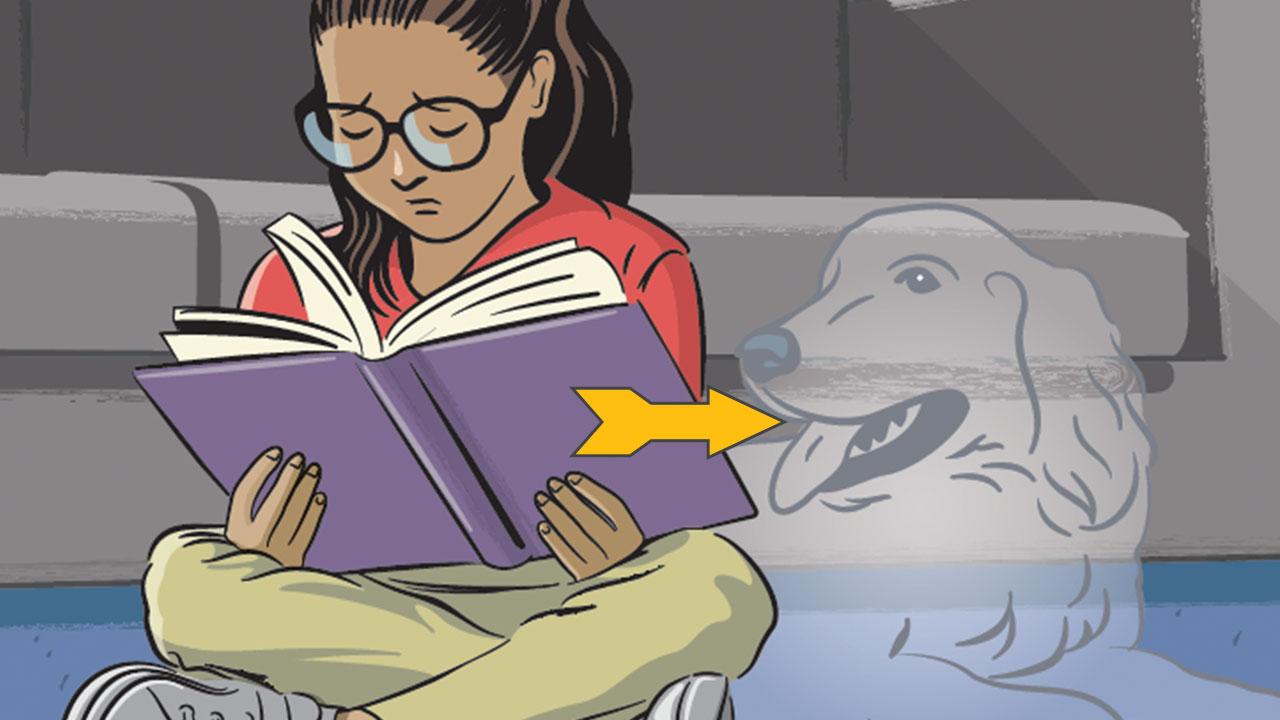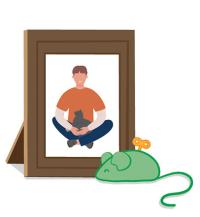
Helping Kids Cope with Pet Loss
Explaining Death at Different Ages
AGES 7 AND UNDER:
- Communicate with calm honesty. Use the words “death” and “dying” rather than “went to sleep” or “went to heaven.” Euphemisms can be confusing and lead to mistrust and misunderstandings. Help your child understand that dying means the pet’s body has stopped working and they will not come back.
- Prepare them so they can enjoy any time left with their pet. If you’ve received news of a terminal illness from your veterinarian, speak with your child as soon as possible in a quiet place so they can process their emotions, ask questions, and have time to say goodbye.
- Don’t lie. Don’t blame the veterinarian or say the pet ran away. This could scare a child away from seeking help for a sick person or pet in the future. And thinking a pet ran away may make them wonder why the pet didn’t love them enough to stay.
- Find an appropriate-age children’s book to help you explain death.
AGES 8 AND OVER:
- Explain the role of euthanasia if that is applicable. If children are mature enough, ask if they want to be present. Closure is very important for children. Before euthanasia, explain that the pet wasn’t going to get better, and that the family chose a kind way to help the pet die without pain.
- Remind teens it’s OK to cry. Teenagers sometimes struggle the most and need to have their feelings validated. Let them know that grief is an appropriate response and everyone expresses it differently.
- Remind kids you’re sad too. It’s okay to let your child see your feelings so they know they aren’t alone in their grief.
- Engage in a goodbye ritual. Scatter the pet’s ashes, hold a memorial service, make a scrap book or create a photo collage. Give your child ways to contribute, like finding a burial place or choosing a favorite toy to bury with your pet.
- Be patient. Parents often want to ease their child’s pain by rushing out and buying another pet. The last thing you want to do is convey the impression that the pet – a family member –is replaceable. Wait until the child expresses an interest in another pet.
Children are very resilient, and they usually learn to accept their pet is gone. If a child persists with nightmares or seems unable to cope, however, it may be necessary to talk with a counselor.
My daughter, Britt, was five when her first pet died – a cockatiel named Zazu. We’d given him a home after finding him scrawny and hungry at the park next to the Sacramento Zoo. He quickly became part of her daily routine, riding her finger or shoulder to the playground near our apartment after school, playing in sink water, and screeching for millet, his favorite treat.
We had him for less than a year when I noticed a sudden change in his behavior. He wasn’t vocalizing. He wasn’t eating or even interested in the millet. I’d raised and rehabilitated dozens of wild birds in my teen years so I knew the warning signs of a sick bird. As a single mom in college, I didn’t have the money to take Zazu to emergency care.
As I feared, Zazu’s little body lay stiff in the bottom of his cage the next morning.
“Will he wake up, mom?” Britt touched his cool feet.
“No, sweetie, his body was done living, but he will always be close to your heart when you think of him.”
I let Britt help me wrap him in tissue paper before we placed his body in a small shoebox. She had obsessively watched “The Lion King” and wanted to bury him in a nearby field so his body could become part of the earth again and complete the circle of life.
Britt carried the shoe box with both hands in front of her, along the path to the field where I dug out a small patch of dirt with a garden trowel. She remained silent as I worked, holding the cardboard close to her chest. When I finished, she squatted to place the box in the ground. We stood for a few moments in silence, holding hands, before I covered the box with dirt and she laid a millet spray on top.
Grief and Mourning
Approximately 70% of U.S. households own a pet, according to the American Pet Products Association’s National Pet Owners Survey. The way we raise those pets has changed significantly in the past 20 years. They live inside our homes and even share our beds.
We view our pets as members of the family, so when the inevitable time comes to say goodbye, we experience similar grief to losing a loved one. Helping our children navigate that grief and subsequent mourning may not be easy, but there are a few things to keep in mind.
Florence Soares-Dabalos, a licensed mental health professional and on-site veterinary hospital staff member at UC Davis, encourages parents to give children the opportunity to express their grief through play, which allows them to work through their feelings.

“Children typically know how to grieve; they don’t let thoughts cloud the process like adults do,” she says. “Journaling and artwork help them deal with emotions. We can help them by supporting that process and letting them talk about their pet when they need to.”
When talking about the pet’s death, it’s important to be honest and use roper terminology, Soares-Dabalos says. Each parent needs to understand their child’s developmental age to decide how much information to communicate.
“Children are concrete thinkers and interpret what we say literally,” says Soares-Dabalos. “It’s ok to use age-appropriate medical terms, but avoid ‘put to sleep’ since we all sleep.”
Most importantly, it is critical to acknowledge your child’s emotions. Grief is an individual process and your child may go through various stages at different times – anger, irritability, denial, guilt, acceptance. Whatever they express, it’s important to let them know these feelings are valid.
Depending on the age, your child may regress (sucking their thumb or temper tantrums that they had outgrown). An older child may withdraw from friends and family for a while. Schoolwork may suffer and they may seem uninterested in extracurricular activities.
Honoring Your Pet
Mourning is the expression of grief, often with others, to facilitate healing. For children, giving them time to mourn and finding a way to honor and memorialize their pet can be powerful steps to healing.
You can help your child memorialize a pet in various ways: framing an ink paw print with a photo; planting a tree or plant in their memory; creating a clay paw print to display; or writing an obituary about the deceased pet.
We view our pets as members of the family, so when the inevitable time comes to say goodbye, we experience similar grief to losing a loved one. Helping our children navigate that grief and subsequent mourning may not be easy, but there are a few things to keep in mind.
“Having your child focus on positive memories of your pet can comfort them during this difficult time,” says Soli Redfield Martin, another hospital staff member who serves as a pet loss grief recovery specialist. “Creating a pet memory box, or a special area in the home where items can be displayed is a great way to remember a beloved pet. Children can collect the collar, leash, favorite toys, paw print and even ashes of their pet in a special box, or somewhere in the home or yard where they have easy access to them. The collected belongings can give your child the chance to honor their memories of time shared with that pet.”

Life Lessons
Losing a companion animal is never easy, but it can be a powerful learning experience to help a child process other loss in their lives. Britt was seven when my brother died suddenly in a motorcycle accident. While I was left reeling with grief, she processed the loss in much the same way she had when she lost Zazu. She wrote her uncle a note in green crayon, telling him he would always be in her heart, and taped it to my mom’s living room wall.
“Any time we normalize death as a part of life, the better our children will be able to cope with other losses, not just death,” Soares-Dabalos says. “By validating their feelings of anger, hopelessness and powerlessness, we help them learn emotional regulation for other losses. They learn that an experience hurts, but they will survive.”
